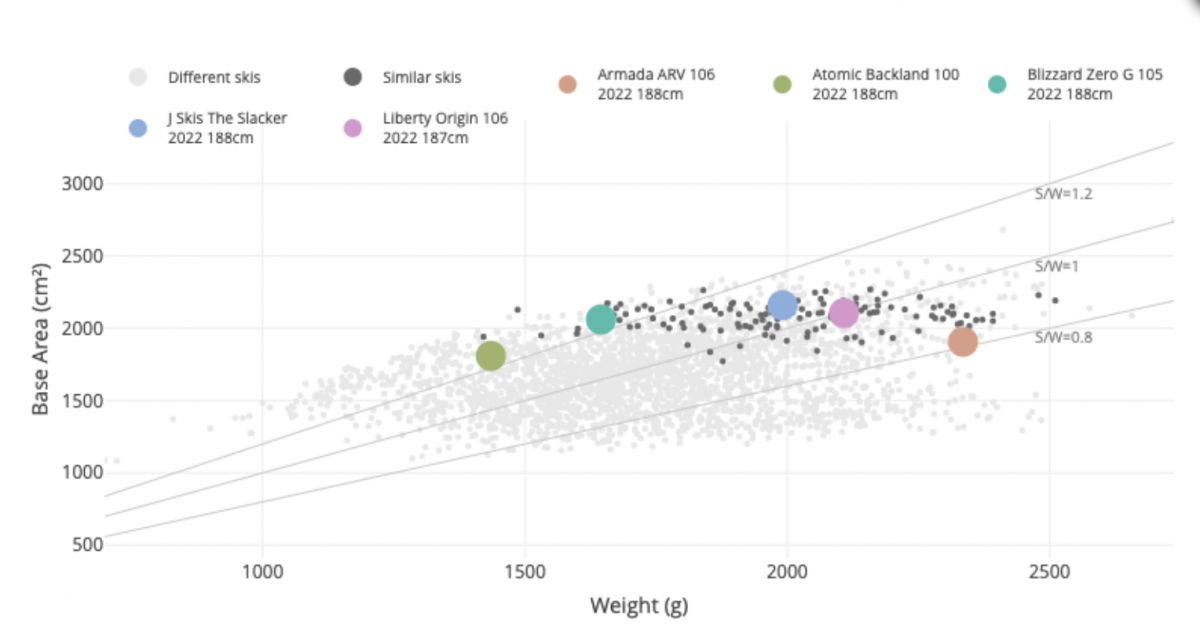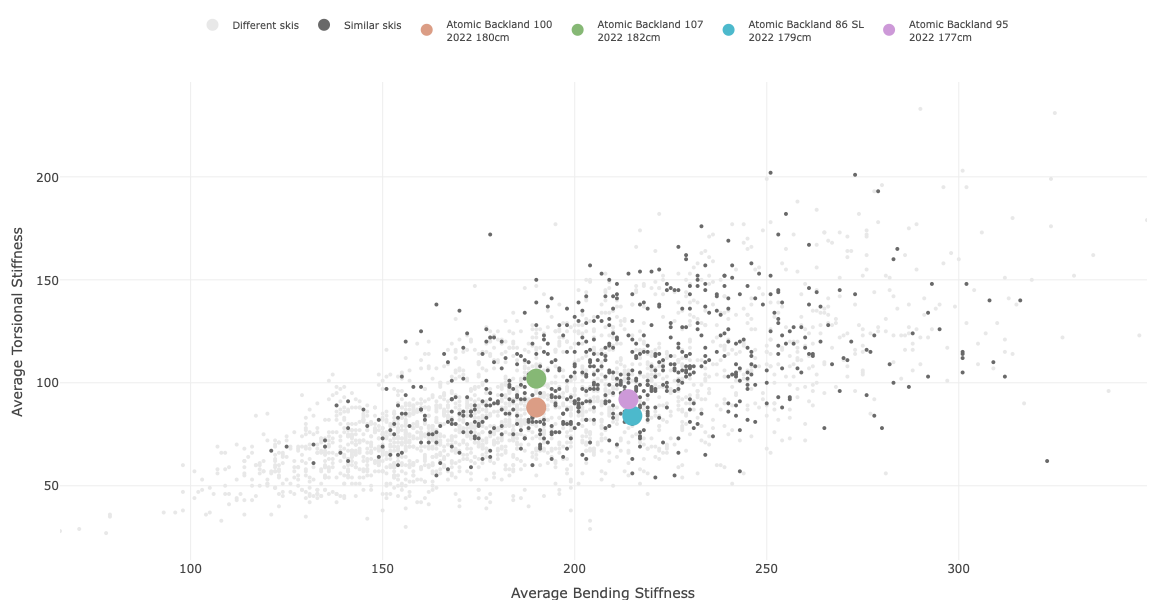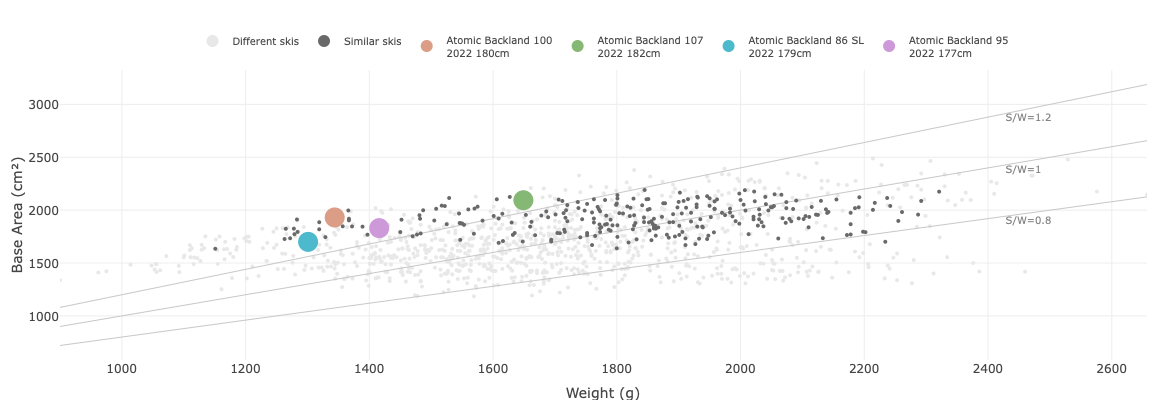
A SoothSki sample chart for ski surface-to-weight ratios. According to SoothSki, the skis selected “have very different Surface-to-Weight Ratios and therefore, should be considered to have very different purposes.” Photo: SoothSki.
Over the years, Lou Dawson informed us all with his data collection, and in particular, his ski weight/surface comparison chart. We love the data. SoothSki, a site presenting troves of ski data, evolves the process, and caught our attention.
Last winter, an email came through with a link to a compelling data tool; SoothSki. SoothSki, an online database run by two Canada-based engineers, Marius Bulota and Alexis Lussier Desbiens, provides a catalog of ski data represented both numerically and visually. The two built a proprietary device that secures the ski and can collect data from tip to tail that reflect the ski’s personality in specific conditions.
According to SoothSki, a ski’s dataset ultimately describes
Geometry – Width along the entire ski
Profile – Tip, tail, rocker, and camber along the entire ski measured at five points
Ski bending stiffness – Distribution along the entire ski measured at five points
Ski torsional stiffness – Distribution along the entire ski measured at five points
Ski weight (center of mass and inertia are also possible)
The data menu is organized into the following sections: Length, Sidecut, Mass & Float, Stiffnesses, Bending and Torsional Stiffness Profiles, and Stiffness vs. Weight.
A compelling aspect of SoothSki is the ability to choose five different skis from a vast catalog of skis. The ski database includes both on-piste and off-piste skis, with, at the moment, not a full complement of the backcountry skis available. (If you’re a backcountry ski brand and you’re reading this, maybe ship off some planks to have tested to include them in the database.) It also appears the technology to measure these variables is for sale, according to SoothSki several companies use the technology in their manufacturing processes to prototype and evaluate design changes, match skis, and determine if the ski’s test numbers align with the design’s intent.
There’s a science to designing and building skis. And a whole ton of art too. With all the variables spec’d and even calibrated to what we hope are James Webb Space Telescope tight measurements. Skis are skis, though, not exploring 13 billion-year-old interstellar dust and light. That said, we like well-built planks designed to do what we think they will do. Still, each skier is unique. Some tall, others short, some big-quad strong, others gazelle-thin with ropey thighs. What SoothSki does is present information that allows us, before dropping upwards of $1000 on skis, to have some idea after interpreting the numbers, how a ski might perform and in what conditions it is best suited for.
The SoothSki Data Collection Process
The How-Tos
The app is semi-complex, and a few times going through the motions of selecting the skis, sorting by specs like mass or waist width, etc., is beneficial. Last sentence on this, dive in, there’s lots of ways to filter if you do not know the specific skis you are looking for. (Those skiers interested in seeing new features added to the ski comparator, this is your chance, let them know in the comments.)
A Test Case: Atomic’s Backland Series
In February, the folks at SoothSki made an intragroup comparison of the Atomic Backland. For a primer on the type of information one might glean from this tool, it’s insightful. For example, there’s only a 5mm waist difference between the Backland 95 and the Backland 100, both in 180cm. However, according to the data and the post-operative analysis, the skis are flat out different, look for yourself, the 95 is the firm snow winner. In contrast, the 100 has better float and soft snow characteristics. Also, the 100 is lighter than the 95, despite its extra surface area. The performance characteristics are in some part due to the skis’ bending and torsional stiffness. The 95 has greater stiffness, in both categories, relative to the 100s: This makes make the 95 more stable at speed and have better edge hold in icier conditions. The 100 will be more playful, easier to pressure into a turn, and, as noted, float better in the soft goods than the 95. Above is one example of using SoothSki to compare and contrast when shopping for skis or just trying to discern why one ski may feel a certain way.

In the torsional stiffness vs bending stiffness graph, we see the Backland 100’s torsional and bending stiffness as less than the 5mm skinnier Backland 95. The 95, although not that much narrower at the waist, will correlate to better hold on firm snow.

This surface vs weight graph comparing the Backland series shows the Backland 100 as the lighter/greater surface area ski compared to the 95.
Zero G 95, Backland 95, and the Blacklight 95 Data Crunch: Stiff and Stiffer
I also just published a final review of the latest Blizzard Zero G 95, a ski many have traditionally flocked to for its edge hold and relative stiffness (it does skis stiff). Like the Backland 95, it’s considered more a firm snow ski than a pow slayer. Although I’m looking at the 2022/2023 version of the Zero G 95 and its new construction and feel, it’s a worthy exercise to see how the bending stiffness and torsional stiffness vary among the different lengths of the 2021/2022 Zero G 95 (157cm, 164cm, 171cm, 178cm, and 185cm). As the lengths increase, both the average bending and torsional stiffnesses increase, respectively.
(The average bending and torsional stiffness are indices measured at five zones from tip to tail in Nm²).
— Average bending stiffness by increasing ski length (Zero G 95) 157cm-185cm: 159, 186, 207, 242, and 275.
— Average torsional stiffness by increasing ski length 157cm-185cm: 62, 62, 75, 84, 104
— In terms of average bending stiffness, the Backland 95 is a 187, the Zero G 95 a 207, and the Blacklight 95 a 235.
– Average torsional stiffness goes like this: Zero G 95 is a 75, Backland 95 a 85, and the Blacklight 95 a 95.

A torsional stiffness vs bending stiffness graph comparing the Blacklight 95, Zero G 95 and Backland 95.

This graph shows the width, tip hight and length, and the tail height and length of three stout 95mm underfoot skis.
While the skis are similar, as most would place them in the ski mountaineering light touring category, they differ in some key ways and the ski comparison allows us to see that. First, the lightest ski, the Blacklight 95, is also the stiffest ski. Relatively speaking, the Zero G 95 has the most tip rocker (still, it’s not a raging powder ski) with a tip height of 55mm and tip rocker length of 273mm. The Blackland 95 has tip height of 49mm and tip rocker length of 243mm. The same measurement for the Blacklight 95 measures out as 48mm and 268, respectively. And this, really, is the tip of the iceberg.
The above speaks to engineering, not so much the art of it all unless we’ve got all three skis on snow, in the same conditions, on the same day, under the same skier, which we don’t. And again, we’re honing in on stiffness here, not weight, rocker, tip width, etc. Data says the Blacklight 95 might be the most demanding for less than confident skiers as the stiffest of the three skis (both bending and torsional).
There is much going on with SoothSki, and for those willing to dive in, more nuanced observations from the examples illustrated above can be gleaned. Have at it.
As we review skis this winter, we’ll be looking at the SoothSki data and keeping an eye on how engineering and art meld in the mountains.
Jason Albert comes to WildSnow from Bend, Oregon. After growing up on the East Coast, he migrated from Montana to Colorado and settled in Oregon. Simple pleasures are quiet and long days touring. His gray hair might stem from his first Grand Traverse in 2000 when rented leather boots and 210cm skis were not the speed weapons he had hoped for. Jason survived the transition from free-heel kool-aid drinker to faster and lighter (think AT), and safer, are better.
